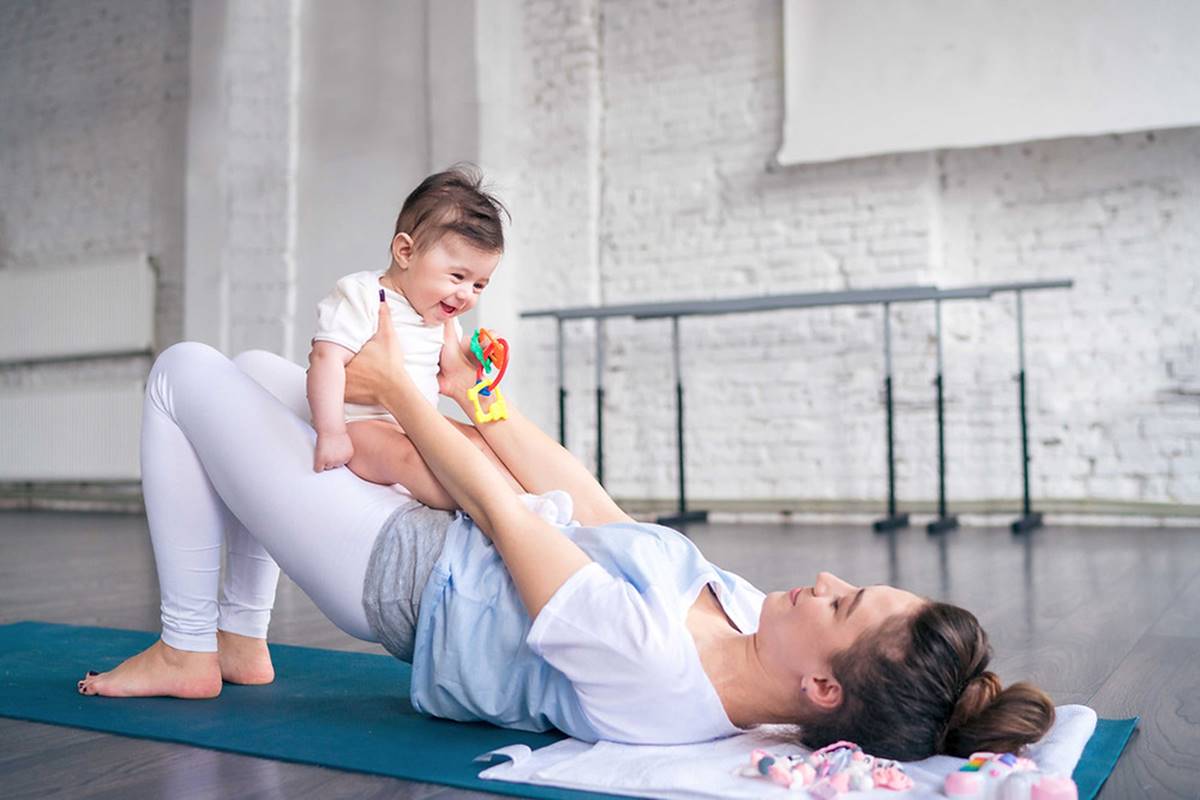

Featured
When Can I Exercise After C-section
Published: September 26, 2023
Learn when it is safe to start exercising after a C-section and discover featured tips for a successful postpartum fitness journey.
Introduction
Welcome to the postpartum journey after a C-section. First and foremost, congratulations on the birth of your baby! While this is undoubtedly an exciting and fulfilling time, it’s also important to take care of yourself during the recovery period. One common question that often arises is when can you start exercising after a C-section.
Recovering from a C-section is a unique experience that requires time, patience, and a gradual return to physical activity. While it’s natural to want to regain your pre-pregnancy fitness level as soon as possible, it’s essential to prioritize your body’s healing process.
In this article, we’ll explore the factors to consider before returning to exercise, the timeline for resuming physical activity, the types of exercises you can start with, precautions to take, and the importance of consulting with your doctor throughout your recovery journey.
Every woman’s recovery after a C-section is different, and it’s crucial to give yourself the time and space you need to heal. Rushing into exercise too soon can potentially hinder your recovery, cause discomfort, and increase the risk of complications. It’s vital to listen to your body and follow your healthcare provider’s guidance on when it’s safe to resume physical activity.
Remember, your body has just experienced major surgery, and it needs time to heal. However, incorporating exercise into your postpartum routine has numerous benefits. Exercise can help improve your mood, increase energy levels, promote weight loss, strengthen your muscles, and enhance overall recovery.
Now that we’ve set the stage, let’s dive deeper into understanding the recovery process after a C-section and the factors you should consider before starting your exercise regimen.
Understanding C-section Recovery
Recovering from a C-section involves more than just healing the incision site. It’s a comprehensive healing process that involves both external and internal recovery. It’s important to have a clear understanding of this process to ensure a safe and successful postpartum journey.
Firstly, the external incision needs time to heal. The incision site is typically closed with either staples, stitches, or surgical glue. Your healthcare provider will guide you on how to care for the incision site, keeping it clean and dry to prevent infection. It’s essential to follow the instructions provided and report any signs of infection such as redness, swelling, or discharge.
Internally, your body needs time to recover from the effects of the surgery. The muscles and tissues that were cut and separated during the C-section need to heal and regain their strength. This internal healing process typically takes around six to eight weeks.
During the early stages of recovery, it’s normal to experience pain, swelling, and discomfort due to the incision and the internal healing process. It’s important to manage your pain with prescribed medications and follow the pain management recommendations provided by your healthcare provider.
Rest and proper self-care are key elements of C-section recovery. It’s crucial to listen to your body and give yourself adequate time to rest and heal. Avoid strenuous activities, lifting heavy objects, or engaging in activities that cause pain or discomfort. It’s important to have a support system in place to help you with daily tasks and caring for your baby during this time of healing.
Maintaining a healthy diet and staying well-hydrated are also important aspects of C-section recovery. Proper nutrition can support your body’s healing process and provide the energy needed for your daily activities and exercise routine.
Understanding the physical changes and challenges associated with C-section recovery is crucial in determining when it’s safe to start exercising. Let’s explore the factors that need to be considered before returning to physical activity after a C-section.
Factors to Consider Before Exercising
Before diving into a post-C-section exercise routine, it’s important to consider several factors to ensure a safe and effective recovery. Taking these factors into account will help you determine when it’s the right time to start exercising and what type of exercises are suitable for your current condition.
1. Healing Progress: The first and foremost factor to consider is how well you are healing. Every woman’s recovery timeline is unique, and it’s important to listen to your body. Make sure your incision site is well-healed, with no signs of infection or discomfort. Your healthcare provider will assess your healing progress at postpartum check-ups and give you the green light to start exercising when appropriate.
2. Physical Strength and Stamina: Giving birth, especially through a C-section, can be physically demanding. Before returning to exercise, it’s essential to regain your strength and endurance levels. Start with gentle movements and gradually increase the intensity and duration of your workouts as you feel more comfortable and confident.
3. Pain and Discomfort Levels: Assess your pain and discomfort levels. While some mild discomfort is expected during the recovery process, severe pain or discomfort should not be ignored. Listen to your body and pay attention to any signs of pain or discomfort during or after exercise. If you experience any unusual symptoms, consult with your healthcare provider.
4. Pelvic Floor Health: Pregnancy and childbirth can weaken the pelvic floor muscles. It’s crucial to ensure that your pelvic floor muscles have regained sufficient strength before engaging in high-impact or intense exercises. Consult with a pelvic floor physiotherapist to assess the condition of your pelvic floor and receive appropriate guidance on pelvic floor exercises.
5. Postural Changes: Pregnancy and childbirth can cause postural changes and back pain. Before starting an exercise routine, it’s important to address these postural changes and strengthen your core muscles to support your spine. Consider including exercises to improve your posture and core strength, such as Pilates or yoga.
6. Energy Levels and Sleep: The early postpartum period can be exhausting due to lack of sleep and increased demands of caring for a newborn. It’s important to ensure you have sufficient energy levels to engage in physical activity. Adequate rest, proper nutrition, and self-care practices will help replenish your energy levels.
Keep in mind that everyone’s recovery journey is different, and it’s crucial to consult with your healthcare provider before starting any exercise regimen. They will assess your individual situation and provide personalized advice based on your specific needs and circumstances.
Now that you are aware of the essential factors to consider, let’s explore the timeline for returning to exercise after a C-section.
Timeline for Returning to Exercise
The timeline for returning to exercise after a C-section varies for each individual and depends on various factors, including the healing progress and overall recovery. It’s important to be patient and not rush into intense workouts too soon. Here’s a general timeline that can guide you in safely incorporating exercise into your postpartum routine:
1. Initial Recovery Period (0-6 Weeks): The first six weeks after a C-section are crucial for the initial healing process. During this time, focus on rest, gentle movements, and light activities. Walking is a great low-impact exercise that helps promote blood circulation and maintain muscle tone without putting too much strain on your body. Begin with short, leisurely walks and gradually increase the duration as you feel comfortable.
2. Postpartum Check-Up (6-8 Weeks): Most healthcare providers conduct a postpartum check-up around six to eight weeks after a C-section. During this visit, they will assess your healing progress, check the incision site, and evaluate your overall well-being. If everything looks good, your healthcare provider may give you the green light to start more moderate exercises, such as light strength training and low-impact cardio exercises like stationary cycling or swimming.
3. Gradual Return to Exercise (8-12 Weeks): After the initial recovery period and with your healthcare provider’s approval, you can gradually increase the intensity and duration of your workouts. Engage in exercises that focus on strengthening your core muscles, such as Pilates or yoga. Also, consider incorporating resistance training exercises to build overall strength. It’s important to listen to your body and not push yourself too hard too soon.
4. Intensifying Your Workouts (12+ Weeks): Around the three-month mark, you can start adding more challenging exercises to your routine. High-intensity interval training (HIIT), aerobic exercises, and strength training can be introduced gradually. However, it’s important to continue incorporating low-impact exercises and giving yourself adequate rest days to prevent overexertion and promote proper recovery.
Remember, this timeline serves as a general guide, and it’s crucial to listen to your body and follow your healthcare provider’s recommendations. If you experience any pain, discomfort, or unusual symptoms during exercise, it’s important to stop and consult with your healthcare provider.
Now that you have a better understanding of the timeline, let’s explore the types of exercises to begin with after a C-section.
Types of Exercises to Begin With
After receiving clearance from your healthcare provider, it’s time to start gradually incorporating exercises into your post-C-section routine. The key is to choose exercises that are gentle on your body and gradually increase in intensity as you regain strength. Here are some types of exercises to begin with:
1. Walking: Walking is a fantastic low-impact exercise that can help ease you back into physical activity. Start with short walks around your neighborhood or on a treadmill. Gradually increase the duration and speed as your body allows.
2. Pelvic Floor Exercises: Strengthening your pelvic floor is crucial after a C-section. Pelvic floor exercises, such as Kegels, can help improve pelvic floor muscle tone and prevent issues like urinary incontinence. Consult with a pelvic floor physiotherapist to learn proper technique and exercises suited to your individual needs.
3. Gentle Pilates or Yoga: Pilates and yoga are great choices for post-C-section exercises as they focus on core strength, flexibility, and relaxation. Look for postnatal Pilates or yoga classes specifically designed for new mothers. These exercises can help improve posture, strengthen your core muscles, and promote overall well-being.
4. Postnatal Fitness Classes: Joining postnatal fitness classes or specialized post-C-section exercise programs can be highly beneficial. These classes often incorporate a combination of cardio, strength training, and stretching exercises tailored to the needs of postpartum women. They provide a supportive environment and knowledgeable instructors who understand the specific considerations of C-section recovery.
5. Strength Training with Light Weights: Incorporating strength training exercises with light weights can help rebuild muscle tone and improve overall strength. Begin with smaller weights and focus on exercises that target major muscle groups. Examples include squats, lunges, bicep curls, and modified push-ups. Gradually increase the weights and intensity as you get stronger.
6. Pelvic Tilts and Abdominal Breathing: Pelvic tilts and abdominal breathing exercises are gentle movements that can help re-engage and strengthen your core muscles. These exercises mainly focus on the deep abdominal muscles, which are essential for restoring core stability and strength. Consult with a fitness professional or a postnatal exercise specialist for proper guidance.
It’s important to note that everyone’s body is different, and what works for one person may not work for another. Always listen to your body and modify exercises as needed. If you experience any pain or discomfort, stop the exercise and consult with your healthcare provider.
Now that you know which exercises to begin with after a C-section, let’s explore some important precautions and tips to keep in mind.
Exercise Precautions and Tips
When returning to exercise after a C-section, it’s important to take certain precautions and follow these helpful tips to ensure a safe and successful postpartum fitness journey:
1. Start Slow and Listen to Your Body: Begin with low-impact exercises and gradually increase the intensity and duration as your body allows. Pay attention to any pain, discomfort, or unusual symptoms. If something doesn’t feel right, modify the exercise or consult with your healthcare provider.
2. Support Your Core: Use a postpartum support belt or abdominal binder during exercise to provide additional support for your abdominal muscles and the incision site. This can help alleviate discomfort and provide stability during physical activity.
3. Warm Up and Cool Down: Before each exercise session, spend a few minutes warming up with gentle movements to increase blood flow to your muscles. Similarly, make sure to cool down with stretches to prevent muscle soreness and promote flexibility.
4. Maintain Good Posture: Focus on maintaining proper posture during exercise to prevent strain on your back and core muscles. Engage your core, keep your shoulders relaxed, and avoid slouching or arching your back.
5. Hydrate and Stay Well-Nourished: Drink plenty of water before, during, and after exercise to stay hydrated. Make sure to consume a balanced and nutritious diet to provide your body with the necessary fuel for recovery and physical activity.
6. Avoid Heavy Lifting and High-Impact Exercises: It’s important to avoid heavy lifting and high-impact exercises, such as running or jumping, for the initial few months after a C-section. These activities can put excessive strain on your healing abdominal muscles. Focus on low-impact exercises and gradually incorporate more intense activities as advised by your healthcare provider.
7. Get Sufficient Rest: Adequate rest is crucial for your recovery. Listen to your body and prioritize rest days between workout sessions. Avoid pushing yourself too hard, as this can hinder the healing process and lead to fatigue or burnout.
8. Stay Consistent, But Be Flexible: Consistency is key when it comes to reaping the benefits of exercise. Aim for regular physical activity, but be flexible with your routine. Some days, you may need to scale back or modify your workouts to accommodate your energy levels, baby’s needs, or other responsibilities.
Remember, every woman’s recovery journey is different. What works for someone else may not work for you, so it’s important to listen to your body, follow the guidance of your healthcare provider, and adjust your exercise routine accordingly.
Now, let’s discuss the importance of monitoring your body’s response during exercise after a C-section.
Monitoring Your Body’s Response
As you return to exercise after a C-section, it’s crucial to closely monitor your body’s response to the physical activity. This means paying attention to any signals or changes that occur during and after exercise. Here are some important aspects to consider when monitoring your body’s response:
1. Pain and Discomfort: Mild discomfort is normal during the initial stages of exercise after a C-section. However, severe or sharp pain should never be ignored. If you experience intense pain during or after exercise, it’s important to stop and rest. Consult with your healthcare provider to determine the cause of the pain and adjust your exercise routine accordingly.
2. Fatigue and Energy Levels: Exercise is meant to energize and invigorate you, but it’s important to be mindful of your energy levels. Feeling slightly fatigued after a workout is normal, but extreme exhaustion or prolonged fatigue could be a sign that you need to modify your routine or take more rest days. Take note of how your body feels and adjust your exercise intensity and frequency accordingly.
3. Bleeding and Discharge: In the early weeks after a C-section, you may still experience some bleeding or discharge. Monitor the amount and type of bleeding during and after exercise. If you notice an increase in bleeding or any unusual discharge, it’s important to contact your healthcare provider, as it could indicate an issue that needs attention.
4. Incision Site: Keep a close eye on your incision site during exercise. Watch for redness, swelling, or signs of infection. If you notice any of these symptoms, it’s important to notify your healthcare provider right away, as they could indicate a complication that needs treatment.
5. Urinary and Bowel Function: Pay attention to any changes in your urinary and bowel function during and after exercise. Weakness, leakage, or difficulty controlling these functions could be a sign of pelvic floor muscle issues. Consult with a pelvic floor physiotherapist or your healthcare provider if you experience any concerns in these areas.
6. Emotional Well-being: Exercise can have a positive impact on your mood and emotional well-being. Take note of how you feel mentally and emotionally after each exercise session. If you notice a significant decline in your mood or experience heightened anxiety or stress, it may be a sign that you need to adjust your exercise routine or seek additional support.
By closely monitoring your body’s response to exercise, you can make informed decisions about your routine, make necessary adjustments, and ensure a safe and effective recovery after a C-section.
Next, let’s discuss the importance of consulting with your healthcare provider throughout your post-C-section exercise journey.
Consultation with Your Doctor
Throughout your post-C-section exercise journey, it’s crucial to maintain open and regular communication with your healthcare provider. Your doctor plays a vital role in guiding and monitoring your recovery progress. Here are the key reasons why consultation with your doctor is important:
1. Individualized Advice: Every woman’s body is unique, and what works for one person may not work for another. Your healthcare provider has a comprehensive understanding of your specific medical history, the details of your C-section, and any other factors that may impact your recovery. They can provide individualized advice about when it’s safe to start exercise, what exercises to avoid, and how to progress in your fitness routine.
2. Monitoring Incision Healing: Your doctor will closely monitor the healing of your incision site. They will assess the incision during postpartum check-ups and ensure that it’s healing properly. By keeping regular appointments, you can receive guidance on how to care for the incision and any red flags to watch out for.
3. Addressing Concerns and Complications: If you experience any concerns or complications related to your C-section or exercise regimen, your doctor is the best person to consult. They can evaluate your symptoms, perform necessary examinations, and make informed decisions about further treatment or adjustments to your routine.
4. Safe Progression of Exercises: Your doctor will guide you on the appropriate progression of exercises based on your recovery and overall health. They can provide recommendations for exercises that target specific areas, such as core strength or pelvic floor, and advice on modifications or adaptations to ensure safety and effectiveness.
5. Management of Other Health Conditions: If you have any pre-existing health conditions or complications, your doctor is essential in managing these in the context of your post-C-section exercise. They can provide guidance on any precautions or modifications needed to tailor your exercise routine to your specific needs.
Remember, your doctor is your partner in your post-C-section recovery journey. Maintaining open lines of communication and following their guidance will help ensure a safe and effective exercise regimen that promotes healing and overall well-being.
As we conclude this article, it’s important to remember that recovering from a C-section takes time and patience. Prioritize self-care, listen to your body, and gradually build up your exercise routine. Seek guidance from healthcare professionals, such as your doctor or a postnatal fitness specialist, to ensure that you are engaging in safe and appropriate exercises suited to your individual circumstances.
By taking these steps and embracing a balanced approach, you’ll be well on your way to regaining your strength, fitness, and overall wellness after a C-section.
Conclusion
Congratulations on embarking on your post-C-section recovery journey! Taking care of yourself after a C-section is essential for a healthy and smooth recovery. As you gradually return to exercise, remember to prioritize your body’s healing process and listen to its cues. Each woman’s recovery is unique, so it’s important to consult with your healthcare provider throughout the process.
Understanding the factors to consider before exercising and following a proper timeline are crucial steps in your post-C-section exercise journey. Begin with gentle exercises like walking, pelvic floor exercises, and yoga or Pilates. Slowly progress to more intense workouts as your body strengthens and heals.
Be mindful of your body’s response to exercise, paying attention to any pain, discomfort, or unusual symptoms. It’s important to take precautions, such as using support belts, maintaining good posture, staying hydrated, and getting sufficient rest. And always consult with your doctor if you have any concerns or complications.
By monitoring your body’s response and staying in close communication with your healthcare provider, you can tailor your exercise routine to suit your individual needs and ensure a safe and effective recovery after a C-section. Remember, consistency and patience are key. Embrace the journey at your own pace, and celebrate each milestone along the way.
Now, go ahead and embark on your post-C-section exercise regimen. Take care of yourself, enjoy the process, and trust in your body’s ability to heal and become stronger. Here’s to your health, well-being, and an empowered post-C-section recovery!




